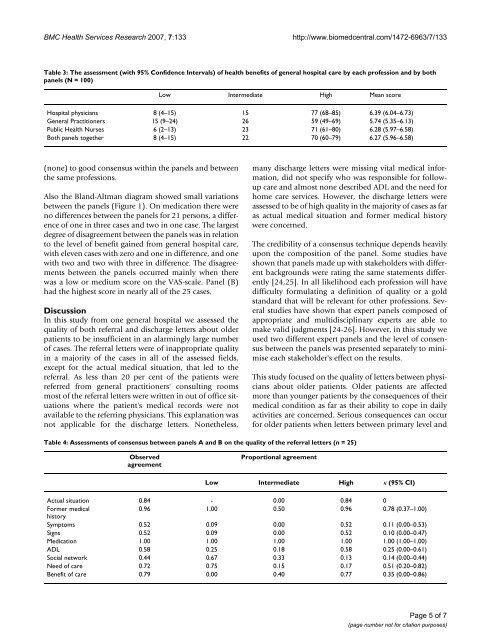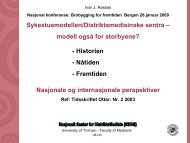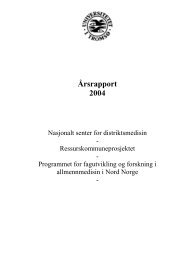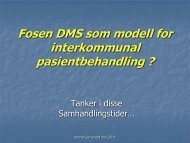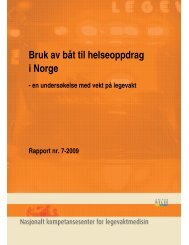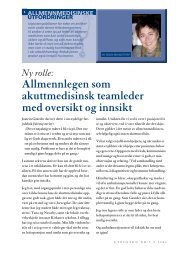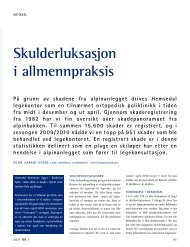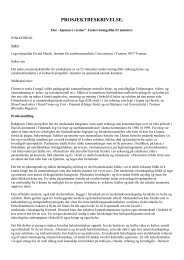Helge Garåsen The Trondheim Model - NSDM
Helge Garåsen The Trondheim Model - NSDM
Helge Garåsen The Trondheim Model - NSDM
You also want an ePaper? Increase the reach of your titles
YUMPU automatically turns print PDFs into web optimized ePapers that Google loves.
BMC Health Services Research 2007, 7:133<br />
http://www.biomedcentral.com/1472-6963/7/133<br />
Table 3: <strong>The</strong> assessment (with 95% Confidence Intervals) of health benefits of general hospital care by each profession and by both<br />
panels (N = 100)<br />
Low Intermediate High Mean score<br />
Hospital physicians 8 (4–15) 15 77 (68–85) 6.39 (6.04–6.73)<br />
General Practitioners 15 (9–24) 26 59 (49–69) 5.74 (5.35–6.13)<br />
Public Health Nurses 6 (2–13) 23 71 (61–80) 6.28 (5.97–6.58)<br />
Both panels together 8 (4–15) 22 70 (60–79) 6.27 (5.96–6.58)<br />
(none) to good consensus within the panels and between<br />
the same professions.<br />
Also the Bland-Altman diagram showed small variations<br />
between the panels (Figure 1). On medication there were<br />
no differences between the panels for 21 persons, a difference<br />
of one in three cases and two in one case. <strong>The</strong> largest<br />
degree of disagreement between the panels was in relation<br />
to the level of benefit gained from general hospital care,<br />
with eleven cases with zero and one in difference, and one<br />
with two and two with three in difference. <strong>The</strong> disagreements<br />
between the panels occurred mainly when there<br />
was a low or medium score on the VAS-scale. Panel (B)<br />
had the highest score in nearly all of the 25 cases.<br />
Discussion<br />
In this study from one general hospital we assessed the<br />
quality of both referral and discharge letters about older<br />
patients to be insufficient in an alarmingly large number<br />
of cases. <strong>The</strong> referral letters were of inappropriate quality<br />
in a majority of the cases in all of the assessed fields,<br />
except for the actual medical situation, that led to the<br />
referral. As less than 20 per cent of the patients were<br />
referred from general practitioners' consulting rooms<br />
most of the referral letters were written in out of office situations<br />
where the patient's medical records were not<br />
available to the referring physicians. This explanation was<br />
not applicable for the discharge letters. Nonetheless,<br />
many discharge letters were missing vital medical information,<br />
did not specify who was responsible for followup<br />
care and almost none described ADL and the need for<br />
home care services. However, the discharge letters were<br />
assessed to be of high quality in the majority of cases as far<br />
as actual medical situation and former medical history<br />
were concerned.<br />
<strong>The</strong> credibility of a consensus technique depends heavily<br />
upon the composition of the panel. Some studies have<br />
shown that panels made up with stakeholders with different<br />
backgrounds were rating the same statements differently<br />
[24,25]. In all likelihood each profession will have<br />
difficulty formulating a definition of quality or a gold<br />
standard that will be relevant for other professions. Several<br />
studies have shown that expert panels composed of<br />
appropriate and multidisciplinary experts are able to<br />
make valid judgments [24-26]. However, in this study we<br />
used two different expert panels and the level of consensus<br />
between the panels was presented separately to minimise<br />
each stakeholder's effect on the results.<br />
This study focused on the quality of letters between physicians<br />
about older patients. Older patients are affected<br />
more than younger patients by the consequences of their<br />
medical condition as far as their ability to cope in daily<br />
activities are concerned. Serious consequences can occur<br />
for older patients when letters between primary level and<br />
Table 4: Assessments of consensus between panels A and B on the quality of the referral letters (n = 25)<br />
Observed<br />
agreement<br />
Proportional agreement<br />
Low Intermediate High κ (95% CI)<br />
Actual situation 0.84 - 0.00 0.84 0<br />
Former medical<br />
0.96 1.00 0.50 0.96 0.78 (0.37–1.00)<br />
history<br />
Symptoms 0.52 0.09 0.00 0.52 0.11 (0.00–0.53)<br />
Signs 0.52 0.09 0.00 0.52 0.10 (0.00–0.47)<br />
Medication 1.00 1.00 1.00 1.00 1.00 (1.00–1.00)<br />
ADL 0.58 0.25 0.18 0.58 0.25 (0.00–0.61)<br />
Social network 0.44 0.67 0.33 0.13 0.14 (0.00–0.44)<br />
Need of care 0.72 0.75 0.15 0.17 0.51 (0.20–0.82)<br />
Benefit of care 0.79 0.00 0.40 0.77 0.35 (0.00–0.86)<br />
Page 5 of 7<br />
(page number not for citation purposes)


